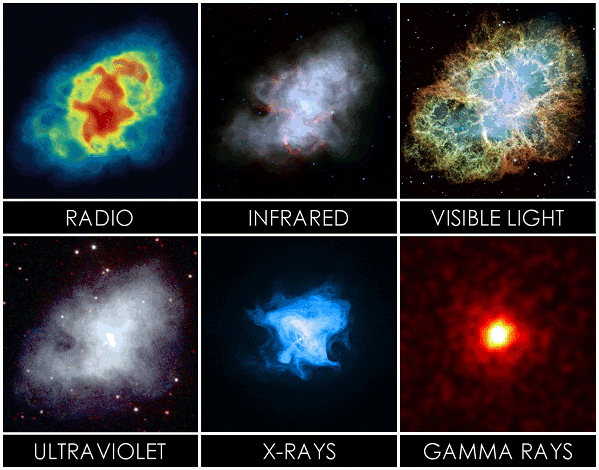Originally published in the December 2021 issue of the CTA Newsletter.
Several decades of efforts and technological breakthroughs have pushed the observational boundaries of Astronomy, which has achieved the capability of ‘seeing’ photons of all existing wavelengths. In this context, the observational range of CTAO represents only a relatively small fraction of the total span of the detectable spectrum, the rest being divided into several bands: radio, infrared, optical, ultraviolet and X-rays.
As it is clear from the figure, which shows the Crab Nebula (one of the most notable gamma-ray sources) seen through different wavebands, each observational technique reveals a distinct and complementary perspective into the source. This is because different frequency ranges are dominantly the result of different physical processes, and an integral view of the object is only possible through a combined, multi-wavelength panorama.

Figure 1: Multiwavelength observation of the Crab Nebula. Credits: NRAO/AUI and M. Bietenholz; NRAO/AUI and J.M. Uson, T.J. Cornwell (radio); NASA/JPL-Caltech/R. Gehrz / University of Minnesota (infrared); NASA, ESA, J. Hester and A. Loll / Arizona State University (visible); NASA/Swift/E. Hoversten, PSU (ultraviolet); NASA/CXC/SAO/F.Seward et al.(X-rays); NASA/DOE/Fermi LAT/R. Buehler (gamma rays).
This already rich observational landscape has been further incremented by other carriers of cosmic information — cosmic rays, neutrinos and gravitational waves — which add truly unique insight into the physical mechanisms of sources and represent a crucial frontier in high-energy astrophysics today. It is nevertheless not possible to directly identify the origin of these other messengers without the help of more accurate observations using photons, and astronomers cannot prescind from a synergetic approach combining electromagnetic and multi-messenger probes to understand the energetic universe.
Multi-wavelength and multi-messenger observations are thus increasingly becoming the norm in astronomy, and will be a central part of the CTAO observational program and strategy, essential for the achievement of its many science goals.
Lessons Learned
Obtaining the complete set of multi-wavelength and multi-messenger data and bringing together the full range of facilities with which CTAO will need to collaborate are important tasks for the current stage of the Observatory’s planning. Previous or existing facilities and space missions had already dealt with similarly large-scale cooperation schemes, from whose experience valuable lessons can be learned.
To this purpose CTAO and CTAC are organizing since April 2021 a series of webinars to discuss the ‘Synergies in the Exploration of the Extreme Universe.’ Specialists involved in the multi-messenger and multi-wavelength planning for previous and current-generation observatories are invited to share their experience and present a perspective into future synergies with CTAO.
While CTAO will be unique among ground-based gamma-ray facilities in the sense that it will operate as an open observatory, proactive planning by the CTAO remains necessary to guarantee the successful exploitation of all potential synergies. Multi-instrument coordination imposes a set of requirements on the Observatory operations which have to be anticipated and implemented well in advance, which in turn implies a careful study of the use cases deriving from each specific science topic.
Future Perspectives for CTAO
Three main avenues for multi-instrument coordination are being investigated: joint planning and cross-matching of survey data, identification and follow-up of multi-wavelength and messenger events, and the coordinated monitoring of transient and variable sources. The main idea of the latter is, from one side to provide real-time information about the observing schedules and plans of CTAO, that can then be matched by other instruments in coordinated campaigns. On the other hand, an ecosystem of facilities needs to be set up to closely support CTAO’s regular observing programs. Efficient, real-time data and schedule sharing protocols and tools are fundamental ingredients for the success of the coordination.
Real-time data sharing, and in particular the capability to trigger and follow-up external alerts, are also key to enable multi-wavelength and messenger science with CTAO, as well as the study of fast transients such as gamma-ray bursts. In the case of neutrinos and gravitational waves, for which event localization is uncertain, not only a rapid, but a coordinated multi-instrumental search for the counterpart source is necessary. Here, the interface with brokers, which receive and transmit tailor-made alert information integrated from multiple sources at once, will be crucial.
In summary, CTAO will be a unique instrument for high-energy astrophysics, capable of detecting with unprecedented sensitivity and accuracy TeV gamma rays produced by the broadest variety of sources and regions of the Cosmos, and multi-instrument cooperation will significantly, and perhaps decisively, increase its science reach.